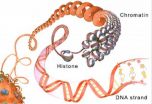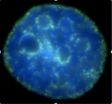(Press-News.org) Cells in our body are constantly dividing to maintain our body functions. At each division, our DNA code and a whole machinery of supporting components has to be faithfully duplicated to maintain the cell's memory of its own identity. Researchers at BRIC, University of Copenhagen, have developed a new technology that has revealed the dynamic events of this duplication process and the secrets of cellular memory. The results are published in Nature Cell Biology.
In 2009, two women at BRIC, University of Copenhagen joined forces to develop a new technology that could elucidate the mystery behind cellular memory. Today, they are celebrating their first big discovery using this technology.
"Our technology can isolate the small molecular building blocks that bind to our DNA strand and organize it into a stringent architecture. Importantly, our technology can follow the dynamic duplication processes in our cells and can therefore reveal the life cycle of these DNA-complexes", says postdoc Constance Alabert who has been leading the laboratory work.
The molecular building blocks that our DNA is wrapped around are called histones and together, the DNA strand and the histones form a stringent structure called chromatin. When our cells divide during development and throughout life to maintain our body functions, the DNA code has to be faithfully duplicated and so do the chromatin and its architecture. Chromatin contains crucial information that tells our genes when to be active and when to be silent. For example, information stored in the chromatin silence liver specific genes in heart cells and vice versa. Therefore, the entire chromatin structure has to be duplicated at each cell division to maintain a cell's memory of its own identity.
It is no longer debated that the chromatin structure is crucial to maintain cell identity, but the how remains. As only hypothesis driven approaches has been available to study the dynamic event of chromatin duplication, only few molecular factors have been linked to the process.
"With our new technology, we have identified 100 new molecular components that appear to be involved in the tightly regulated process of chromatin duplication and thereby maintenance of cell memory. Thus, we provide a robust technology and the first comprehensive resource to address fundamental questions regarding maintenance of cell identity", says associate professor Anja Groth, who is heading the laboratory.
Understanding the fundamental principles of how chromatin is faithfully duplicated is essential to understand how our organism is developed and maintained, and also how diseases such as cancer arise. If cells lose their chromatin memory, they can potentially develop into cancer cells and form tumours. Such a loss of what is also called 'epigenetic' memory is now known to be involved in almost all cancer types. The next step for the researchers will be to decipher the mode of action of the 100 new chromatin factors.
INFORMATION: END
New technology detect cellular memory
2014-02-24
ELSE PRESS RELEASES FROM THIS DATE:
Researchers make the invisible visible
2014-02-24
The 2003 development of the so-called hyperpolarization technique by a Danish research was a groundbreaking moment that made it possible to see all the body's cells with the help of a new contrast agent for MRI scans. Researchers from Aarhus have now taken another big step towards understanding the body's cells and with it also the development of diseases:
"With the hyperpolarization method, sensitivity to specific contrast agents is up to 10,000 times higher than with a traditional MRI scanning. What we have now documented is that with the hyperpolarization MRI scanning ...
Team converts sugarcane to a cold-tolerant, oil-producing crop
2014-02-24
CHAMPAIGN, Ill. — A multi-institutional team reports that it can increase sugarcane's geographic range, boost its photosynthetic rate by 30 percent and turn it into an oil-producing crop for biodiesel production.
These are only the first steps in a bigger initiative that will turn sugarcane and sorghum – two of the most productive crop plants known – into even more productive, oil-generating plants.
The team will present its latest findings Tuesday (Feb. 25) at the U.S. Department of Energy's ARPA-E Energy Innovation Summit in Washington, D.C.
"Biodiesel is attractive ...
Pointing is infants' first communicative gesture
2014-02-24
VIDEO:
Catalan researchers have studied the acquisition and development of language in babies on the basis of the temporary coordination of gestures and speech. The results are the first in showing...
Click here for more information.
Catalan researchers have studied the acquisition and development of language in babies on the basis of the temporary coordination of gestures and speech. The results are the first in showing how and when they acquire the pattern of coordination ...
The chemistry of Sriracha: Hot sauce science
2014-02-24
WASHINGTON, Feb. 24, 2014 — Forget ketchup and mustard — Sriracha might be the world's new favorite condiment. Beloved by millions for its unique spicy, garlicky, slightly sweet flavor, the chemistry of "rooster sauce" is the subject of the American Chemical Society's latest Reactions video. The video is available at http://youtu.be/U2DJN0gnuI8.
INFORMATION:
Subscribe to the series at Reactions YouTube, and follow us on Twitter @ACSreactions to be the first to see our latest videos.
The American Chemical Society is a nonprofit organization chartered by the U.S. ...
Uninsured adolescents and young adults more likely to be diagnosed with advanced cancer
2014-02-24
ATLANTA – February 24, 2014 – A new American Cancer Society study shows that uninsured adolescents and young adults were far more likely to be diagnosed with late-stage cancer, which is more difficult and expensive to treat and more deadly, compared to young patients with health insurance. The study, published early online, will appear in the March issue of the journal CANCER.
The study's authors says their data suggest a way forward for cancer control efforts in the adolescent and young adult (AYA) population, a group that has benefited the least from recent progress ...
Creating animated characters outdoors
2014-02-24
This news release is available in German.
So far, film studios have had to put in huge amounts of effort to set monsters, superheroes, fairies or other virtual characters into real feature film scenes. Within the so-called motion capturing process, real actors wear skintight suits with markers on them. These suits reflect infrared light that is emitted and captured by special cameras. Subsequent to this, the movements of the actors are rendered with the aid of software into animated characters. The most popular example of this is "Gollum" from the film Lord of the ...
Nanotracer tester tells about wells
2014-02-24
A tabletop device invented at Rice University can tell how efficiently a nanoparticle would travel through a well and may provide a wealth of information for oil and gas producers.
The device gathers data on how tracers – microscopic particles that can be pumped into and recovered from wells – move through deep rock formations that have been opened by hydraulic fracturing.
Drilling companies use fracturing to pump oil and gas from previously unreachable reservoirs. Fluids are pumped into a wellbore under high pressure to fracture rocks, and materials called "proppants," ...
Study reveals new ways deadly squirrelpox is transmitted to red squirrels
2014-02-24
Native red squirrels have declined throughout Britain and Ireland for the last century due to a combination of habitat loss and the introduction of the North American eastern grey squirrel. But more recently its few remaining populations have been devastated by an insidious pox virus passed to them by the alien invaders.
A study by the biodiversity and conservation research centre Quercus at Queen's University Belfast (QUB), and published in the journal PLOS ONE, found the situation may be worse than previously thought as the disease appears to have multiple modes of ...
GM spuds beat blight
2014-02-24
In a three-year GM research trial, scientists boosted resistance of potatoes to late blight, their most important disease, without deploying fungicides.
The findings, funded by the Biotechnology and Biological Sciences Research Council and The Gatsby Foundation, will be published in 'Philosophical Transactions of the Royal Society B' on 17 February.
In 2012, the third year of the trial, the potatoes experienced ideal conditions for late blight. The scientists did not inoculate any plants but waited for races circulating in the UK to blow in.
Non-transgenic Desiree ...
McMaster researchers discover secret of bowel movement
2014-02-24
Hamilton, ON (Feb. 24, 2014) – High performance athletes like Olympians can push their bodies to optimal potential, but some of the ways the human body actually works is still a mystery.
Now McMaster University researchers have cleared up one aspect of how the bowels move that had mystified scientists for, well, forever.
Gastroenterology scientist Jan Huizinga and his team have learned that of the two types of movement, the segmentation motion occurs when not one but two sets of pacemakers interact with each other to create a specific rhythm. Then they work together ...







